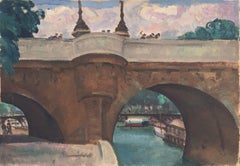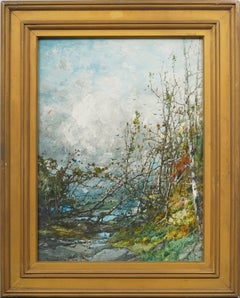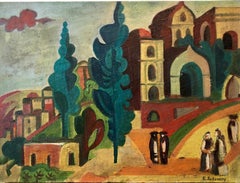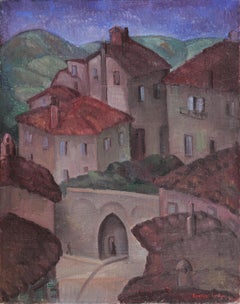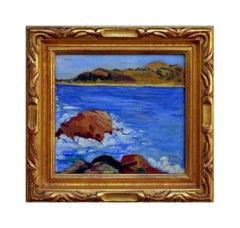Rinaldo Cuneo Paintings
American, 1877-1939
Dubbed “The Painter of San Francisco." Well received at the Panama Pacific International Exhibition in 1915. Born in San Francisco, California and raised in the North Beach area, Rinaldo Cuneo was a painter of landscape, still lifes, city views and muralist who, commissioned by the Federal Art Project adminstrators, painted murals in Coit Tower in San Francisco in 1934. His studio and cottage in San Francisco, later in his career, had a panoramic view of the bay from Telegraph Hill. His family were painters including two of his brothers, Cyrus and Egisto Cuneo, and several family members were founders of the Tivoli Opera Company in San Francisco.
He served in the Spanish-American War and then studied at the Mark Hopkins Institute of Art with Arthur Mathews and Gottardo Piazzoni. He then went to London where he joined his brother Cyrus and also studied in Paris at the Académie Colarossi.
In 1913, he had his first exhibition, which was held at the Helgesen Gallery in San Francisco, and in 1916 and 1917, he worked with a tug boat service at San Anselmo. He also pursued his painting interests, and in 1928, he took a painting trip to Arizona.
Source: Edan Hughes, Artists in California, 1786-1940to
1
Overall Width
to
Overall Height
to
1
1
1
1
1
1
1
1
1
1
783
709
702
697
1
Artist: Rinaldo Cuneo
'The Pont Neuf, Sunset', Paris, Académie Colarossi, Oakland, NYMOMA, SFMOMA
By Rinaldo Cuneo
Located in Santa Cruz, CA
'The Pont Neuf, Sunset' by Rinaldo Cuneo.
Paris, Académie Colarossi, Oakland, New York Museum of Modern Art, San Francisco Museum of Modern Art
----
Signed lower right, 'Rinaldo Cun...
Category
1920s Modern Rinaldo Cuneo Paintings
Materials
Gouache, Illustration Board
Related Items
Antique American Hudson River School Framed Landscape Signed Original Painting
Located in Buffalo, NY
Antique Hudson River School landscape painting by William Louis Sonntag, Sr. (1822 - 1900). Watercolor and gouache on board. Framed. Signed. Measuring: 13 by 17 inches overall, and ...
Category
1870s Modern Rinaldo Cuneo Paintings
Materials
Watercolor, Gouache, Board
$1,475
H 19 in W 25 in D 2 in
Outside the Synagogue Russian Judaica Oil Painting
By Emmanuel Snitkovsky
Located in Surfside, FL
This piece came from the collection of the Bezalel Art Gallery on the Lower East Side of New York City.
Emmanuil Snitkovsky is an internationally known artist, sculpture and poet.
Emmanuil Snitkovsky was born into a family of artists and scholars from the Odessa Art College in Russia. Immersed in the traditions of Russia art, he approaches form, line, space and color with relentless vision and impeccable technique.
Two highly successful artists, the husband and wife team of Emmanuil and Janet Snitkovsky have exhibited a selection of eight large Judaic paintings at the Chabad Chassidic Art Institute (Chai Gallery) in Crown Heights. Three of those paintings are truly singular visions of Jewish Art that cause us to stop and reassess our preconceptions about the meaning and importance of their subjects. Emmanuil and Janet Snitkovsky were both born in the Ukraine in the 1930′s. Emmanuil was trained in Odessa in public monument art, and Janet majored in fashion at the Lvov Decorative Art Institute. After both narrowly survived the devastation of the Second World War in Stalin’s Russia, they began to collaborate on state sponsored art works in 1962. For ten years, they worked on grandiose public sculptural projects to commemorate the fallen Russian heroes of the Second World War in Moscow, Kiev, Tula and Kazan. They were
exemplary Soviet Realists working for the Soviet regime. Eventually, this career became untenable for them, both as artists and as Jews, when they clashed with Soviet officialdom over a commission to commemorate the Babi-Yar massacre. The Soviets refused to acknowledge this massacre of 100,000 Jews and eventually suppressed the memorial. In 1978, Emmanuil and Janet arrived in New York and began to recreate their artistic lives. In the ensuing 25 years, they have been quite successful, exhibiting widely in the United States and Europe. They have nurtured a hybrid style of painting and sculpture called “Renaissance Revival” combining contemporary and classical subjects in a stylized realism that evokes both the American regionalist Thomas Hart
Benton and the Italian Renaissance master Sandro Botticelli. The works are highly proficient, polished, and commercial productions in a quirky decorative style. They have continued to accept sculptural projects that have not shied away from kitschy realistic sculptures of Charlie Chaplin as “The Kid,” The Little Tramp” and Buster Keaton as “Cameramen.” In some ways, they have appropriated American culture just as they once accepted Soviet culture.
Janet, a graduate of the Lvov College, was invited- by virtue of the high honors she
achieved there- to matriculate at the Lvov University of Art. Such an opportunity is extremely rare for anyone, particularly for someone of Jewish descent. Their works of art are included in collections of the Japanese Imperial Family...
Category
1980s Modern Rinaldo Cuneo Paintings
Materials
Canvas, Oil, Illustration Board
Arch Rock, Pacific Grove, California, Vintage 1970s Painting, Coastal Landscape
Located in Grand Rapids, MI
Filastro Mottola (American, 1915 - 2008)
Signed: Mottola (Lower, Right)
" Arch Rock " Pacific Grove, Calif., circa 1970s-1980s
(Titled on Verso)
Acrylic on Illustration Board
21"...
Category
Mid-20th Century Modern Rinaldo Cuneo Paintings
Materials
Acrylic, Illustration Board
Late 19th Century Original English Landscape of a Cottage in Cambria
Located in Soquel, CA
Late 19th Century Original English Landscape of a Cottage in Cambria
Wonderful original antique painting of a thatched cottage in Cambria by...
Category
1880s Impressionist Rinaldo Cuneo Paintings
Materials
Illustration Board, Gouache
$1,650
H 10.5 in W 13.5 in D 2 in
Simka Simkhovitch WPA Artist Oil Painting Gouache American Modernist Powerline
By Simka Simkhovitch
Located in Surfside, FL
Simka Simkhovitch (Russian/American 1893 - 1949)
This came with a small grouping from the artist's family, some were hand signed some were not.
These were studies for larger paintin...
Category
1930s American Modern Rinaldo Cuneo Paintings
Materials
Oil, Gouache, Board
"Union Square" NYC American Scene Social Realism Modernism WPA Mid-20th Century
By Agnes Hart
Located in New York, NY
"Union Square" NYC American Scene Social Realism Modernism WPA Mid-20th Century
Agnes Hart (American, 1912-1979)
"Union Square, New York City"
Sight: 14 1/2 x 21 1/2 inches
Gouache...
Category
1940s American Modern Rinaldo Cuneo Paintings
Materials
Gouache, Board
Last Light
Located in Denver, CO
Devin Michael Robert's "Last Light" is an original, handmade oil painting that depicts a rendering of a landscape.
Category
21st Century and Contemporary Rinaldo Cuneo Paintings
Materials
Gouache, Illustration Board
Orange Grove Landscape
By Dorr Bothwell
Located in Los Angeles, CA
Orange Grove Landscape, 1941, gouache on illustration board, 14 inches x 18 inches (image), 22 x 26 inches (framed) signed and dated lower right, newly framed with museum glazing
...
Category
1940s American Modern Rinaldo Cuneo Paintings
Materials
Gouache, Board
Country Auction, The New Yorker Magazine Cover
Located in Fort Washington, PA
Medium: Gouache on Illustration Board
Signature: Signed Lower Right
March 28, 1953 Magazine Cover of The New Yorker
Category
1950s Rinaldo Cuneo Paintings
Materials
Gouache, Illustration Board
"Night Express"
Located in Astoria, NY
John Schweikhard (American, b. 1937), "Night Express", Gouache on Board, signed lower right, signed and titled to verso, blue painted wood frame. Image: 23.5" H x 20.25" W; frame: 25...
Category
Mid-20th Century Modern Rinaldo Cuneo Paintings
Materials
Gouache, Board
Alfa Romeo Traffic Stop - Playboy Cartoon - Mid Century
Located in Miami, FL
The enduring appeal of Ben Denison's work is not what would be considered corny men's magazine humor of the early 1960s, but rather his masterful painting skills. In the present wor...
Category
1960s Modern Rinaldo Cuneo Paintings
Materials
Gouache, Board, Pencil
Goodyear Factory
Located in Fort Washington, PA
Date: 1918
Medium: Grisaille Gouache on Illustration Board
Dimensions: 15.75" x 22.38"
Signature: Signed Lower Right
Category
1910s Rinaldo Cuneo Paintings
Materials
Gouache, Illustration Board
Previously Available Items
Early Modernist View of San Francisco, California
By Rinaldo Cuneo
Located in Santa Cruz, CA
Signed lower right, 'Rinaldo Cuneo' (American, 1877-1939) and painted circa 1925.
Framed in a custom, 24K hand-carved gilt frame by Freelance Gilding, Carmel, CA
Framed Dimensions: 32.75''H x 3.25''D x 26.75''W
Rinaldo Cuneo first studied at the Mark Hopkins Institute under Gottardo Piazzoni...
Category
1920s Modern Rinaldo Cuneo Paintings
Materials
Canvas, Oil
Early 20th Century Carmel Point Lobos and Monastery Beach Seascape
By Rinaldo Cuneo
Located in Soquel, CA
Gorgeous, vibrant early 20th century seascape painting of Point Lobos looking toward Monastery Beach, Carmel by Rinaldo Cuneo (American, 1877-1939). Signed "Cuneo" lower right. Presented in a giltwood frame. Image, 11"H x 12"W.
Dubbed “The Painter of San Francisco." Well received at the Panama Pacific International Exhibition in 1915. Born in San Francisco, California and raised in the North Beach area, Rinaldo Cuneo was a painter of landscape, still lifes, city views and muralist who, commissioned by the Federal Art Project adminstrators, painted murals in Coit Tower in San Francisco in 1934. His studio and cottage in San Francisco, later in his career, had a panoramic view of the bay from Telegraph Hill.
His family were painters including two of his brothers, Cyrus and Egisto Cuneo, and several family members were founders of the Tivoli Opera Company in San Francisco.
He served in the Spanish-American War and then studied at the Mark Hopkins Institute of Art with Arthur Mathews and Gottardo...
Category
Early 1900s American Impressionist Rinaldo Cuneo Paintings
Materials
Board, Oil
H 16 in W 17 in D 2 in
Rinaldo Cuneo paintings for sale on 1stDibs.
Find a wide variety of authentic Rinaldo Cuneo paintings available for sale on 1stDibs. You can also browse by medium to find art by Rinaldo Cuneo in board, paint, gouache and more. Much of the original work by this artist or collective was created during the 20th century and is mostly associated with the modern style. Not every interior allows for large Rinaldo Cuneo paintings, so small editions measuring 17 inches across are available. Customers who are interested in this artist might also find the work of Alfred Wands, Charles Movalli, and Marc Dalessio. Rinaldo Cuneo paintings prices can differ depending upon medium, time period and other attributes. On 1stDibs, the price for these items starts at $3,500 and tops out at $6,500, while the average work can sell for $5,000.
